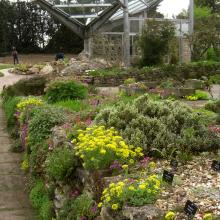
The new Alpine House at the Royal Botanic Garden opened to the public last Thursday, and Spurtle has now taken a look.
Recently described by some architectural ignoramus as resembling a crashed Stealth bomber (Issue 218), the structure’s open front results not from an accident or oversight, but is rather a carefully considered way to ‘maximise air circulation and re-enforce the hardiness of the plants’. This will help to prevent soft growth and stagnant air, both of which make the specimens – like idle, cosseted, insolent, gum-chewing schoolchildren glued to their Gameboys – more susceptible to disease.
The overhanging canopy keeps off the rain – something which high-level snow cover would do in the wild.
At ground level, the alpines are being planted in holes filled with gravel, sand and a cultivating medium in a substrate of tufa – a form of very porous limestone rich in calcium and magnesium carbonate which favours distinctive and rich montane plants around the world. Tufa blocks are often cut and polished for facing new buildings or, in Germany – where the Botanics examples came from and the locals take these things seriously – building roads.
Tufa encourages plants to grow slowly and in a ‘naturalistically’ compact form, significantly improving their quality and survivability, according to Alpines Supervisor John Mitchell. In this respect they differ from alpines grown under cover in clay pots, like those decadent, peelie-wally softies in the older (1975) Alpine House adjacent.
Edinburgh’s Royal Botanic Garden has been growing alpines for 140 years, but for most of that time the majority of plants have not been on display. Today, scientific and conservation work on the species is particularly important as they are useful indicators of global climate change.
To be honest, there isn’t a lot to see at the moment, but over time the tufa will develop into a ‘living wall’.
‘Its colonists will provide a constantly changing spectacle as different species come into flower and fruit and extend new foliage across the seasons,’ rhapsodises one of the interpretation boards.
In the meantime, impatient botanists can console themselves with a brief display of TV presenters when the Alpine House features in the BBC’s Beechgrove Garden on Thursday 6 June.